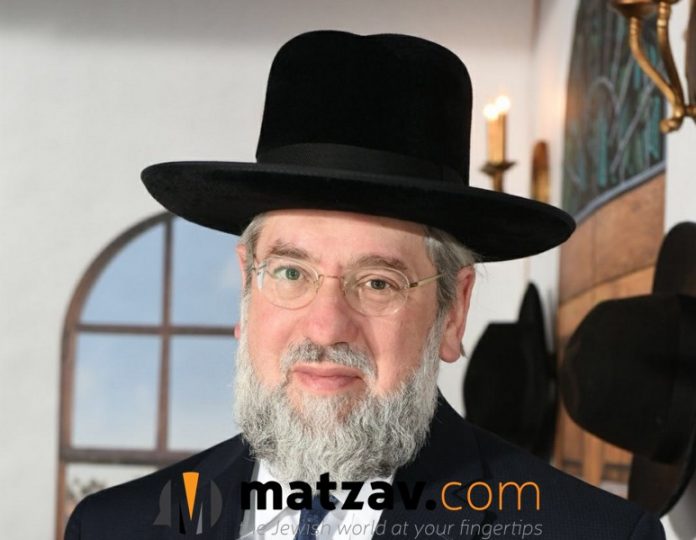
By Rabbi Pinchos Lipschutz
The Ramchal (Derech Hashem, Avodas Hazeman, Sukkah) discusses the ananei hakavod that protected the Jewish people in the midbar. He says that they consisted of six clouds that surrounded the Jewish people on all sides and a seventh cloud that paved the way for them, straightening out the ground they were to traverse upon and killing all matters of pestilence on the way.
While the ananim appeared to offer only physical protection, directing the nation as they traveled to Eretz Yisroel and keeping their enemies at bay, there was also a spiritual shield. As the ananim surrounded them, the Jews were able to understand that they were a chosen people and separate from all the nations of the world. The ananim thus signified for the Jewish people that they lived on a higher, more spiritual plane than everyone else. That awareness helped them live up to their potential to serve as a holy nation.
While we no longer have the ananim to protect us physically, the spiritual component of their task is still prevalent. There is a spiritual light that emanates from Shomayim and surrounds the tzaddikim, separating and raising them from the others. Tzaddikim, though they are with us in this world, are removed from many of the physical aspects of our lives and operate on a higher, spiritual level.
Famously, the Vilna Gaon barely slept more than two hours a night. Rav Aharon Leib Shteinman subsisted on 150 grams of porridge each day. Living among us, Rav Chaim Kanievsky learns virtually all day, much as his father-in-law, Rav Yosef Shalom Elyashiv, did. Tzaddikim are motivated by different things than regular mortals, who have not perfected their thoughts, impulses and appetites for fleeting pursuits.
The Ramchal writes that on Sukkos, all of Klal Yisroel is surrounded by the walls and roof of the sukkah, which are reminiscent of the ananei hakavod that surrounded the Jews in the midbar, setting them apart. When we sit in the sukkah under the tzeila demeheimnusah, we are on a different level, separated from everyone and everything.
To understand the depth of this statement, we quote the Maharal (Chiddushei Aggados, Rosh Hashanah 16b), who discusses the difference between the life of a tzaddik and the life of a rosha. A tzaddik is connected to Hashem, the Source of all life, whereas a rosha, even when he is alive, is disconnected from Hashem. A tzaddik is therefore referred to as alive even after his neshomah has passed into the other world, because he remains connected to Hashem, as he was in this world. A rosha is referred to as dead, because even in this world he is not connected to the Source of life.
With this, we can understand what the Ramchal writes in his peirush to the Rosh Hashanah machzor. He states that when we say “chaim,” it refers to those upon whom the kedusha shines and connects to, for they are the ones who are connected to the Source of all life and are thus considered living.
On Sukkos, everyone who enters a sukkah is connected to Hashem on the level of the great tzaddikim. We now have a new understanding of the widely quoted Zohar that says that when we sit in the sukkah, we are b’tzeila demeheimnusah. In the sukkah, the light of kedusha shines upon us as it shines upon tzaddikim all year. On Sukkos, we have a special connection to Hashem.
This is why on Sukkos we are joyous, as the posuk (Devorim 16:14-15) states, “Vesomachta bechagecha vehoyisa ach someiach.” Sukkos is Zeman Simchoseinu, because on these days, we can attain the highest levels that man can reach.
The Tur (625) asks that the sukkah mentioned in the posuk (Vayikra 23:42-43) refers to the ananei hakavod, which protected the Jews upon their exit from Mitzrayim. Therefore, it should follow that the Yom Tov of Sukkos, which commemorates the ananei hakavod, should be during Nissan, the month the Jews left Mitzrayim, and not during Tishrei, following the Yomim Noraim.
The Vilna Gaon (Shir Hashirim 1:4) is mechadeish that the ananei hakavod we commemorate on Sukkos are not those clouds that surrounded and protected the Jewish people when they left Mitzrayim. If we were commemorating them, Sukkos would be during Nissan. Rather, what we are celebrating on Sukkos is that Hashem returned his Shechinah, via the ananim, to the Jewish people following the sin of the Eigel. When the Jews sinned, Hashem removed His Shechinah and the ananim from them. Moshe Rabbeinu ascended the mountain to plead for forgiveness and returned on Yom Kippur. The next day, 11 Tishrei, he addressed the Bnei Yisroel and informed them of the mitzvah of constructing the Mishkon. He appealed to the people to donate the materials necessary to build the Mishkon, which would be the dwelling place of the Shechinah.
The Torah relates (“baboker baboker,” Shemos 36:3) that the people brought their donations for the next two days, the 12th and 13th of Tishrei. On the 14th of Tishrei, the builders of the Mishkon weighed, measured and accepted the gold and other materials from Moshe. On the 15th, they began to build. The clouds returned as the construction of the Mishkon began.
Sukkos, says the Vilna Gaon, celebrates the return of the Shechinah cloud that was dependent on the construction of the Mishkon. That happened on the 15th of Tishrei, the first day of Sukkos.
His explanation answers a question posed by the Chasam Sofer who asked that the ananei hakavod protected the Jews every day of the year in the desert, why is it that we only commemorate them on Sukkos and what connection does the holiday of Sukkos have with the protective clouds. With the revelation of the Gaon that we are celebrating the return of the ananim on the first day of Sukkos, this Yom Tov is the perfect time to commemorate that.
Rav Meir Simcha of Dvinsk (Meshech Chochmah, Shemos 23:16) strengthens what the Gaon says, stating that prior to the deliverance of the second Luchos (Shemos 23:16 and 34:22), the Torah refers to the Yom Tov as “Chag Ha’asif.” It is only later on (Devorim 16:13) that the Torah refers to the Yom Tov as “Chag HaSukkos.”
Observing Sukkos during Tishrei following the Yomim Noraim has an added bonus in that it brings us to the level that the Jews were on following Hashem’s acceptance of their teshuvah after the chet ha’Eigel. Just as Hashem returned his Shechinah to them and shined the light of his countenance upon them, so too, following our teshuvah, Hashem shines His light upon us b’tzeila demehemnusah, in the sukkah.
This may also be why on Sukkos we merit visits from the Ushpizin, because we are on the level of great tzaddikim, with the special ohr shining upon us and with a direct connection to kedusha. It is only on Sukkos that the avos can visit with us mortals.
Since the sukkah envelops us with kedusha, we perform the mitzvah of sukkah with our entire body, unlike other mitzvos, such as tefillin, which we do with our arms and head.
With this, we can understand the ruling of the Mishnah Berurah (639:2) that when inside the sukkah, we should discuss Torah and holy matters and minimize mundane and silly talk. He adds that we must be careful not to speak lashon hora or rechilus there.
When we sit in the sukkah, we are b’tzeila demeheimnusa, with Hashem’s light shining upon us as we are connected to Hashem. Since lashon hora causes the Shechinah to depart, we are cautioned to abstain from speaking lashon hora in the sukkah. Also, in order to maintain the special, rare and holy connection, we must prove ourselves worthy of it.
We hope that the new year will prove to be an improvement over the year that thankfully has ended. Many are still suffering from the ravages of the virus, which is not yet done with us. Many of our brethren around the world are unable to daven in a shul and those in Eretz Yisroel are under lockdown. Nobody knows what the winter will bring or how the U.S. elections will turn out. We turn our eyes heavenward and pray for the best. But this should not put a damper on our personal simcha during z’man simchoseinu. We must rejoice in the mitzvos and the opportunities for spiritual growth and satisfaction.
The Vilna Gaon said that the most difficult mitzvah to perform is the obligation to be happy on Yom Tov, “Vesomachta b’chagecha vehoyisa ach someiach.” The mitzvah obligates us to be in a state of happiness for the duration of Sukkos, even in the face of troubling or tragic situations that may befall us and can cast a specter of gloom.
In prior generations, observing the mitzvah of sukkah didn’t always come easy. Zoning laws banning construction of “sheds” were used to deter Jews from building a sukkah, and that was from the easier problems. In the concentration camps, life was no simple matter and a sukkah presented its own challenges. Jews were moser nefesh, endangering their very lives for the opportunity to partake of their meager rations b’tzeila demeheimnusa.
As they sat on the floor of their humble sukkahs, they felt the warm embrace of the holy light and the kedusha. Despite their privations, with intense simcha d’mitzvah, they joyfully recited the brocha of “asher kideshanu b’mitzvosav v’tzivonu leisheiv basukkah,” thanking Hashem for sanctifying them and commanding them to sit in the sukkah, despite the difficulties involved. And then they made the brocha of shehecheyonu, thanking Hashem for keeping them alive in that awful time.
Nothing any of us is going through compares to what Jews experienced in Auschwitz and the many other camps. Nothing is comparable to being confronted by a pogrom, or the Inquisition, or the Crusaders, or the rabid anti-Semitism of the church and the communists and the socialists. Yet in all periods, Jews observed the mitzvos of sukkah and dalet minim with devotion, fervor and inner joy.
When we see a sukkah, we are looking at proof that even today we are not alone. The Shechinah is with us. When we see people surround the bimah holding aloft their dalet minim, we are witnessing proof that “netzach Yisroel lo yeshakeir.” Life can be tough, pandemics are rough, but there is no reason to be down and depressed.
We look forward to the day when we will merit sitting in “sukkas oro shel Livyoson” with the coming of Moshiach speedily in our day.











